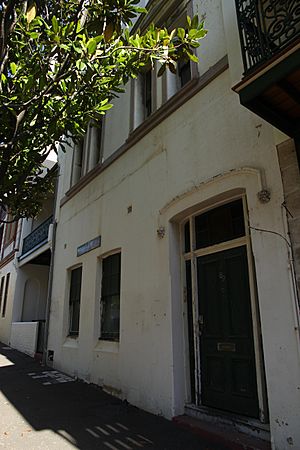69 Windmill Street, Millers Point facts for kids
Quick facts for kids 69 Windmill Street, Millers Point |
|
|---|---|

69 Windmill Street, pictured in 2019.
|
|
| Location | 69 Windmill Street, Millers Point, City of Sydney, New South Wales, Australia |
| Built | 1845–1901 |
| Architectural style(s) | Victorian Italianate |
| Official name: Terrace; Hit or Miss Hotel; Empire Service Hostel | |
| Type | State heritage (built) |
| Designated | 2 April 1999 |
| Reference no. | 853 |
| Type | Terrace |
| Category | Residential buildings (private) |
| Lua error in Module:Location_map at line 420: attempt to index field 'wikibase' (a nil value). | |
69 Windmill Street in Millers Point, Sydney, is a special building with a long history. It started as a home and shop, then became a famous hotel called the Hit or Miss Hotel. Later, it was used as the Empire Service Hostel for new arrivals to Australia. Today, it is a heritage-listed building, meaning it's protected because of its historical importance. It was built between 1845 and 1901 and is a great example of Victorian Italianate style architecture.
Contents
A Look Back in Time
Millers Point is one of the oldest European settlements in Australia. It has always been a busy place for ships and port activities. This area holds many stories from the past.
The Land's Story
The land where 69 Windmill Street stands was once given to a man named Thomas Stevens. He came to Australia in 1817 and later became a free man. By 1825, he was working and had started a family with Catherine Larkins.
Around 1845, Thomas Stevens lived on Windmill Street. Records show his building was two stories high with seven rooms. It was made of stone and brick. This building was known as 6 Windmill Street at the time. Windmill Street was a lively area, with many public houses (like pubs or inns) nearby.
The Hit or Miss Hotel
In 1840, there was already a "Hit or Miss Hotel" in Windmill Street, but its exact spot isn't known. After Thomas Stevens passed away in 1850, his wife Catherine turned their home at 6 Windmill Street into a public house. She named it the "Hit or Miss Hotel."
The Stevens family ran the hotel for many years, from 1852 until 1912. The name "Hit or Miss" might have come from Thomas's love for hunting. Unlike other hotels that served specific groups like sailors, this one welcomed everyone.
Catherine Stevens died in 1867. Her sons, John and Thomas Jr., continued to live and work at the hotel. In 1879, John Stevens added an awning to the building. Later, his grandson, John M. Stevens, took over running the hotel.
Around 1893, there were some concerns about the hotel's condition. This might have led the family to rebuild it. After a family legal case was settled in 1897-1898, John M. Stevens and other family members started building new structures. They built a new "Hit or Miss Hotel" and a block of apartments next door. Some old materials were reused in the new buildings. The new hotel was finished by April 1899.
The new hotel was a three-story brick building with fancy Italianate decorations. It had a wooden porch and beautiful lead-light doors. The architect who designed it is not known.
Around 1900, an outbreak of bubonic plague in Sydney led the government to take over many properties in the port area, including Millers Point. This was done to improve housing and port facilities. The Sydney Harbour Trust was created to manage these changes.
By 1907, the NSW Government owned the hotel. In 1911, the hotel's address changed from 61 to 69 Windmill Street.
In 1923, the hotel's license was not renewed, and it closed as a pub. The owners and staff received money to help them.
From Hotel to Hostel
In May 1925, the building reopened with a new purpose. It became a place for new arrivals to Australia, called the Empire Service Hostel. It provided a place to stay for migrant families coming from overseas. By 1926, the hostel had housed 300 migrants.
Becoming Apartments
The Empire Service Hostel closed in 1930. The Sydney Harbour Trust then changed the building into apartments. They removed some old parts and added new kitchens and bathrooms.
In 1936, the property was transferred to the Maritime Services Board (MSB). Later, in 1983, it was given to the Housing Commission. This government department works to provide good housing for people. They started a program to improve the homes in Millers Point.
At first, the Housing Commission preferred to house people who had worked in the shipping industry. But as the port changed, they started housing people from all over Sydney who needed a place to live.
Today, the property is managed as five apartments by RUN property, on behalf of the NSW Land and Housing Corporation.
Building Features
This building is a three-story house from the late Victorian era. It has fancy decorations around its windows and on its roofline. It is made of painted brick walls and has a corrugated iron roof. The windows and doors are made of painted timber. It is built in the Victorian Italianate style.
The outside of the building is in good condition.
Why It's Important
This building was constructed in the 1880s as part of a redevelopment of older buildings in the area.
It is part of the Millers Point Conservation Area. This area is special because it's a well-preserved neighborhood with homes and public spaces from the 1830s. It shows how the landscape was changed and developed in the 19th century.
The building was officially listed on the New South Wales State Heritage Register on 2 April 1999. This means it is recognized as an important historical site that needs to be protected.
Images for kids


